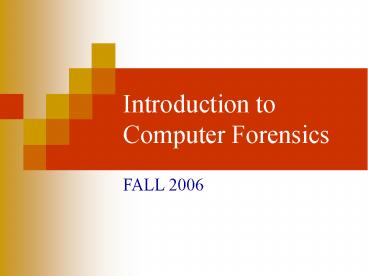Introduction to Computer Forensics - PowerPoint PPT Presentation
Title:
Introduction to Computer Forensics
Description:
Introduction to Computer Forensics FALL 2006 What is Information? Liebenau and Backhouse ... monitor display the results processed by the computer Memory CPU ... – PowerPoint PPT presentation
Number of Views:209
Avg rating:3.0/5.0
Title: Introduction to Computer Forensics
1
Introduction to Computer Forensics
- FALL 2006
2
- The fundamental concern of forensic computing
activity is for the accurate extraction of
INFORMATION from computer-based systems, such
that it may be presented as admissible evidence
in court - (Sammes and Jenkinson 2000)
3
What is Information?
- Liebenau and Backhouse (1990), Understanding
Information - Numerous definitions have been proposed for the
term information, and most of them serve well
the narrow interests of those defining it. - These definitions are all problematic
4
What is Information?
- Liebenau and Backhouse (1990), Understanding
Information - information cannot exist independently of
the receiving person who gives it meaning and
somehow acts upon it. That action usually
includes analysis or at least interpretation, and
the differences between data and information must
be preserved, at least in so far the information
is data arranged in meaningful way to some
perceived purpose
5
- Computer system holds data.
- Any information that we (the receiving persons)
may extract from this data is a result of our
analysis or interpretation of it in some
meaningful way for some perceived purposes. - We have to have a set of interpretative rules
which we apply to the data in order to extract
the information. (Sammes and Jenkinson 2000)
6
Computer
- Electronic device
- Accepts data - input
- Processes it according to a given set of
instructions - Produces results - output
Computer
7
- Input, Output, Computer Program
- Input unprocessed data
manipulated by the computer - Output processed information or results
produced by the computer - The set of instructions
- that the computer follows
- is called a computer program
8
Computer System
- hardware
- the physical equipment used to process a data
- software
- computer programs
9
Hardware
10
Hardware
Main Memory
Input Devices
Output Devices
CPU
11
Input/Output Devices
- Input devices
- keyboard, mouse
- enter data and programs into
- the computer
- Output devices
- printer, monitor
- display the results processed
- by the computer
12
Memory
- Main Memory
- Nonpermanent
- Rapid Access
- Low Capacity
- Secondary Storage
- Permanent
- Non Rapid
- High Capacity
Bit - Binary Digit Byte 8 bits KB KiloBytes
1024 bytes 210 MB MegaBytes 1,048,576
bytes 220 GB GigaBytes 230 bytes
13
CPU Central Processing Unit
- Control Unit
- Directs the processing operations
- Coordinates the flow of data to Main Memory and
ALU
- Arithmetic Logic Unit (ALU)
- performs
- Arithmetic operations
- Logic operations
14
Software
- Operating Systems
- DOS
- UNIX
- Windows
- Application Software
- Word
- Power Point
- Emacs, Pico
15
References
- Liebenau, J. and Backhouse, J. (1990)
Understanding information an introduction.
London, Macmillan - Tony Sammes and Brian Jenkinson (2000), Forensic
Computing A Practitioner's Guide, Springer
Verlag































